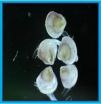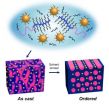(Press-News.org) Four of the most common mosquito pesticides used along the east and Gulf coasts show little risk to juvenile hard clams and oysters, according to a NOAA study.
However, the study, published in the on-line journal Archives of Environmental Contamination and Toxicology, also determined that lower oxygen levels in the water, known as hypoxia, and increased acidification actually increased how toxic some of the pesticides were. Such climate variables should be considered when using these pesticides in the coastal zone, the study concluded.
"What we found is that larval oysters and hard clams can withstand low levels of pesticide use, but they are more sensitive to pesticides if their ecosystem is suffering from local climate stressors like hypoxia and acidification," said the study's lead author, Marie DeLorenzo, Ph.D., NOAA environmental physiology and microbiology program lead with NOAA's Centers for Coastal Ocean Science. "Hopefully these data will benefit both shellfish mariculture operations and environmental resource agencies as they manage the use of mosquito control pesticides near their coastal ecosystems."
Commercial shellfishing has a large economic national impact. NOAA Fisheries estimated that U.S. oyster and hard clam landings for 2010 were worth nearly $118 million and $41 million, respectively. Shellfish growers, however, are concerned that pesticide spraying near the coastlines may contaminate both their hatcheries and source waters. This is compounded by a lack of data on the toxicity of mosquito insecticides for these shellfish.
These ecologically and economically important species inhabit tidal marsh habitats along the U.S. Atlantic and Gulf of Mexico coastlines. Clams and oysters are also important for the coastal ecosystem because they filter water, improving water quality, and serve as habitat and food sources for other estuarine species.
Approximately 200 mosquito species live in the United States. In addition to causing painful itchy bumps to people, mosquito bites can transmit serious diseases such as malaria, dengue fever, and West Nile virus. One approach to controlling mosquitoes is to apply pesticides by spraying from planes or trucks over a large area. However, to effectively control mosquitoes, the pesticides must target species which live in aquatic habitats that are also home to sensitive estuarine species. This may pose a risk to coastal environments. Also, since many residential communities where the pesticides may be used are near these coastal aquatic habitats, the potential for direct overspray or unintentional drift into these waters is increased.
The study sought to address a lack of toxicity data for mosquito control pesticide effects on shellfish early life stages. The research team examined the toxicity of four mosquito control pesticides (naled, resmethrin, permethrin, and methoprene) to larval and juvenile life stages of hard clams (Mercenaria mercenaria) and Eastern oysters (Crassostrea virginica).
Lethal thresholds were determined for the four pesticides, and differences in sensitivity were found between chemicals, species, and life stages tested. Overall, clams were more susceptible to mosquito control pesticides than oysters. Naled, an organophosphate chemical, was the most toxic compound in oyster larvae, while resmethrin was the most toxic compound in clam larvae. Decreased swimming activity was observed after four days in larval oysters and decreased growth was found in juvenile clams and oysters after 21 days.
Using a hazard assessment, which compared the toxicity thresholds to concentrations expected in the environment, the researchers calculated a low-level of risk to clams and oysters from application of these pesticides for mosquito control.
The researchers also tested the pesticides' toxicity under climate stress conditions. The more extreme climate conditions caused increased pesticide toxicity.
The study did not address the impacts of the pesticides on other shellfish such as shrimp or lobsters.
INFORMATION:
NOAA's mission is to understand and predict changes in the Earth's environment, from the depths of the ocean to the surface of the sun, and to conserve and manage our coastal and marine resources. Join us on Facebook, Twitter, Instagram and our other social media channels.
NOAA scientists find mosquito control pesticide low risk to juvenile oysters, hard clams
Climate stressors, however, increase risk to shellfish
2014-06-09
ELSE PRESS RELEASES FROM THIS DATE:
Antiviral therapy may prevent liver cancer in hepatitis B patients
2014-06-09
DETROIT – Researchers have found that antiviral therapy may be successful in preventing hepatitis B virus from developing into the most common form of liver cancer, hepatocellular carcinoma (HCC).
That was the finding of a study published in the May issue of Clinical Gastroenterology and Hepatology. Investigators from Henry Ford Health System in Detroit, Geisinger Health System in Danville, Pa., and Kaiser Permanente in Honolulu, Hawaii and Portland, Ore. participated in the study, along with investigators from the Centers for Disease Control and Prevention in Atlanta. ...
How much fertilizer is too much for the climate?
2014-06-09
EAST LANSING, Mich. — Helping farmers around the globe apply more-precise amounts of nitrogen-based fertilizer can help combat climate change.
In a new study published in this week's Proceedings of the National Academy of Sciences, Michigan State University researchers provide an improved prediction of nitrogen fertilizer's contribution to greenhouse gas emissions from agricultural fields.
The study uses data from around the world to show that emissions of nitrous oxide, a greenhouse gas produced in the soil following nitrogen addition, rise faster than previously expected ...
Coral, human cells linked in death
2014-06-09
SAN DIEGO (June 6, 2014) — Humans and corals are about as different from one another as living creatures get, but a new finding reveals that in one important way, they are more similar than anyone ever realized.
A biologist at San Diego State University has discovered they share the same biomechanical pathway responsible for triggering cellular self-destruction. That might sound scary, but killing off defective cells is essential to keeping an organism healthy.
The finding will help biologists advance their understanding of the early evolution of multicellular life, ...
Researchers recast addiction as a manageable disease
2014-06-09
Neuroscientists agree that abuse of drugs hijacks circuits in the brain that are crucial for decision-making, but society as a whole tends to stigmatize addicted people for lacking self-control. Slowly but steadily, scientists say, they are making important progress in changing the perception of addiction as they identify new therapeutic interventions that could render addiction into the equivalent of a manageable disease like diabetes.
A group of addiction researchers, for one, recently recommended to the Commission on Narcotic Drugs, part of the United Nations Office ...
Protein could put antibiotic-resistant bugs in handcuffs
2014-06-09
DURHAM, N.C. -- Staph infections that become resistant to multiple antibiotics don't happen because the bacteria themselves adapt to the drugs, but because of a kind of genetic parasite they carry called a plasmid that helps its host survive the antibiotics.
Plasmids are rings of bare DNA containing a handful of genes that are essentially freeloaders, borrowing most of what they need to live from their bacterial host. The plasmids copy themselves and go along for the ride when the bacteria divide to copy themselves.
A team from Duke and the University of Sydney in ...
Parent and child must get enough sleep to protect against child obesity
2014-06-09
URBANA, Ill. – Is sleep one of your most important family values? A new University of Illinois study suggests that it should be, reporting that more parental sleep is related to more child sleep, which is related to decreased child obesity.
"Parents should make being well rested a family value and a priority. Sleep routines in a family affect all the members of the household, not just children; we know that parents won't get a good night's sleep unless and until their preschool children are sleeping," said Barbara H. Fiese, director of the U of I's Family Resiliency Center ...
Land quality and deforestation in Mato Grosso, Brazil
2014-06-09
PROVIDENCE, R.I. [Brown University] — The state of Mato Grosso is the epicenter of an agricultural revolution in Brazil. During the last 15 years, expansion of agriculture in the state has helped Brazil become one of the world's top producers of soy, corn, cotton, and other staple crops. Despite the increase in production, the rate at which Amazon forestland in the state was cleared to make room for new farmland slowed significantly in the second half of the last decade.
Much of the credit for slowing deforestation has been given to government policies and intervention, ...
Does 'free will' stem from brain noise?
2014-06-09
VIDEO:
UC Davis researchers found that the pattern of electrical activity in the brain immediately before making a decision can predict the choice made. This video shows how these experiments are...
Click here for more information.
Our ability to make choices — and sometimes mistakes — might arise from random fluctuations in the brain's background electrical noise, according to a recent study from the Center for Mind and Brain at the University of California, Davis.
"How ...
Humanitarian liking on Facebook
2014-06-09
"Liking" a page on the social networking site Facebook is a new form of civic engagement and humanitarian support, so concludes research published in the International Journal of Web Based Communities. According to the paper's authors social motives and an emotional response underpinned users' inclination to like, or follow, a page, rather than their simply seeking information and news.
Petter Bae Brandtzaeg and Ida Maria Haugstveit of Scandinavian research organization SINTEF in Oslo, Norway, surveyed more than 400 Facebook users about their habits on the site and their ...
Berkeley Lab researchers create nanoparticle thin films that self-assemble in 1 minute
2014-06-09
The days of self-assembling nanoparticles taking hours to form a film over a microscopic-sized wafer are over. Researchers with the U.S. Department of Energy (DOE)'s Lawrence Berkeley National Laboratory (Berkeley Lab) have devised a technique whereby self-assembling nanoparticle arrays can form a highly ordered thin film over macroscopic distances in one minute.
Ting Xu, a polymer scientist with Berkeley Lab's Materials Sciences Division, led a study in which supramolecules based on block copolymers were combined with gold nanoparticles to create nanocomposites that ...
LAST 30 PRESS RELEASES:
Making lighter work of calculating fluid and heat flow
Normalizing blood sugar can halve heart attack risk
Lowering blood sugar cuts heart attack risk in people with prediabetes
Study links genetic variants to risk of blinding eye disease in premature infants
Non-opioid ‘pain sponge’ therapy halts cartilage degeneration and relieves chronic pain
AI can pick up cultural values by mimicking how kids learn
China’s ecological redlines offer fast track to 30 x 30 global conservation goal
Invisible indoor threats: emerging household contaminants and their growing risks to human health
Adding antibody treatment to chemo boosts outcomes for children with rare cancer
Germline pathogenic variants among women without a history of breast cancer
Tanning beds triple melanoma risk, potentially causing broad DNA damage
Unique bond identified as key to viral infection speed
Indoor tanning makes youthful skin much older on a genetic level
Mouse model sheds new light on the causes and potential solutions to human GI problems linked to muscular dystrophy
The Journal of Nuclear Medicine ahead-of-print tip sheet: December 12, 2025
Smarter tools for peering into the microscopic world
Applications open for funding to conduct research in the Kinsey Institute archives
Global measure underestimates the severity of food insecurity
Child survivors of critical illness are missing out on timely follow up care
Risk-based vs annual breast cancer screening / the WISDOM randomized clinical trial
University of Toronto launches Electric Vehicle Innovation Ontario to accelerate advanced EV technologies and build Canada’s innovation advantage
Early relapse predicts poor outcomes in aggressive blood cancer
American College of Lifestyle Medicine applauds two CMS models aligned with lifestyle medicine practice and reimbursement
Clinical trial finds cannabis use not a barrier to quitting nicotine vaping
Supplemental nutrition assistance program policies and food insecurity
Switching immune cells to “night mode” could limit damage after a heart attack, study suggests
URI-based Global RIghts Project report spotlights continued troubling trends in worldwide inhumane treatment
Neutrophils are less aggressive at night, explaining why nighttime heart attacks cause less damage than daytime events
Menopausal hormone therapy may not pose breast cancer risk for women with BRCA mutations
Mobile health tool may improve quality of life for adolescent and young adult breast cancer survivors
[Press-News.org] NOAA scientists find mosquito control pesticide low risk to juvenile oysters, hard clamsClimate stressors, however, increase risk to shellfish







